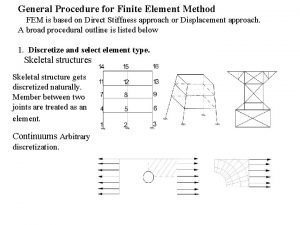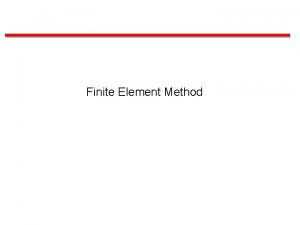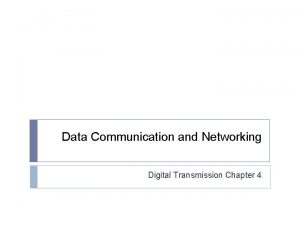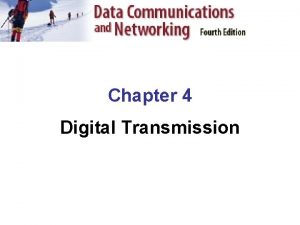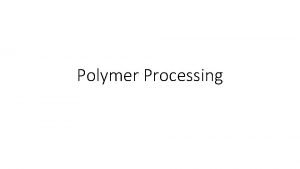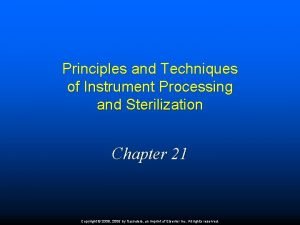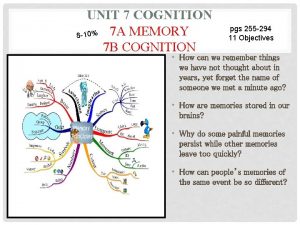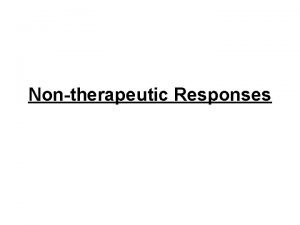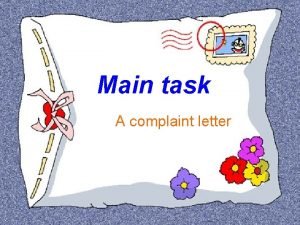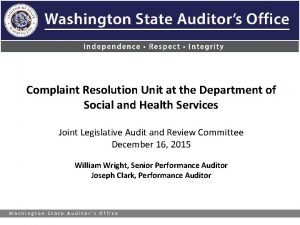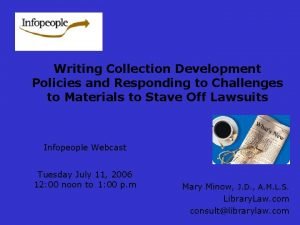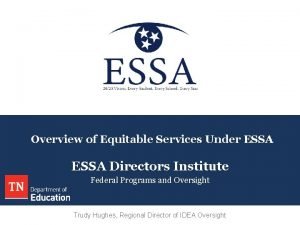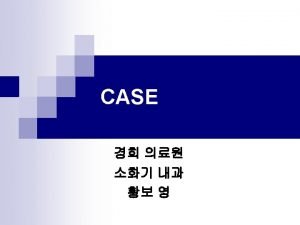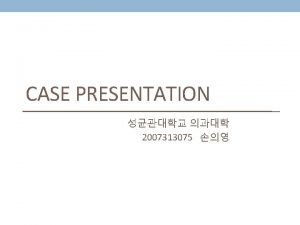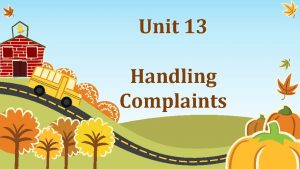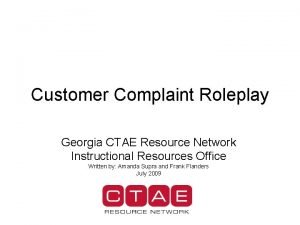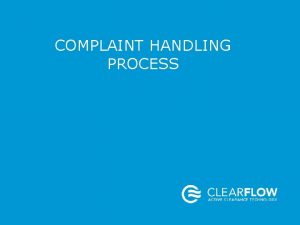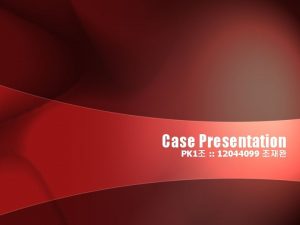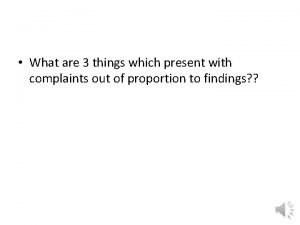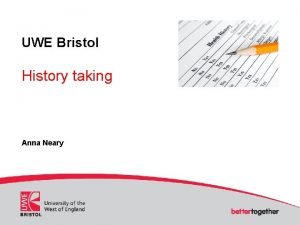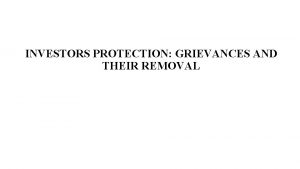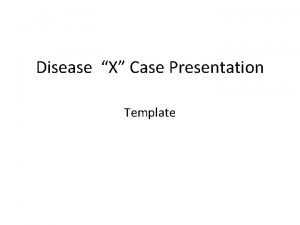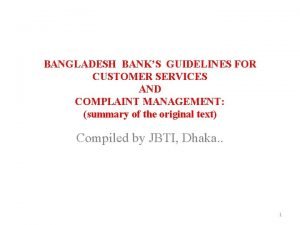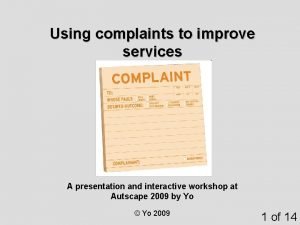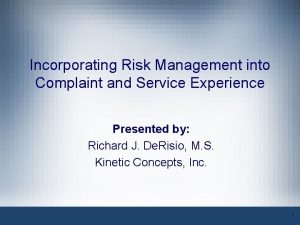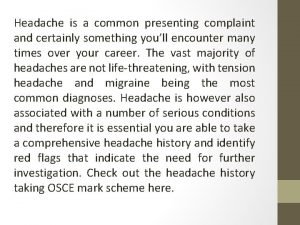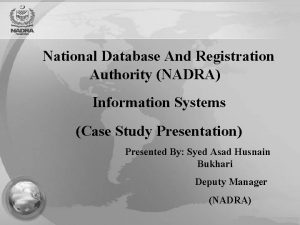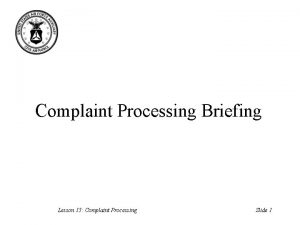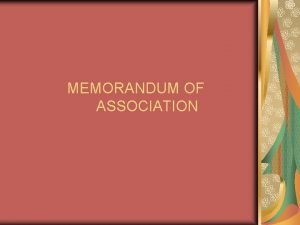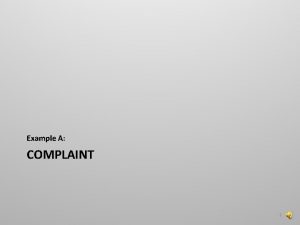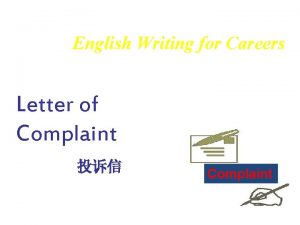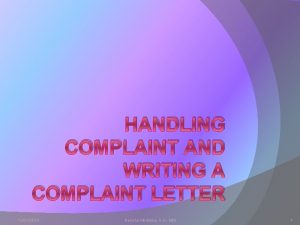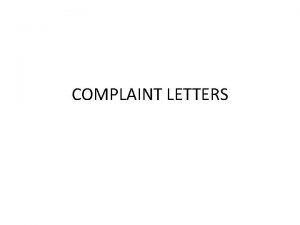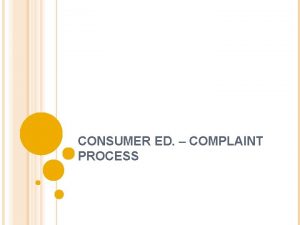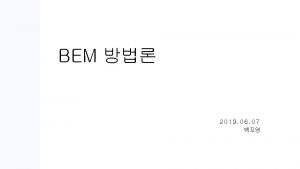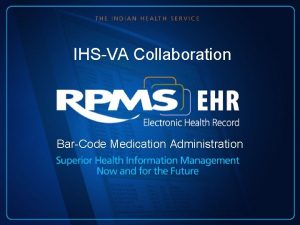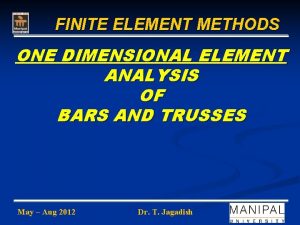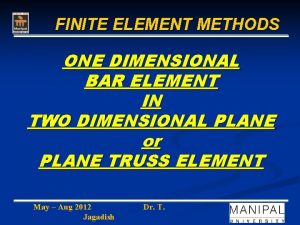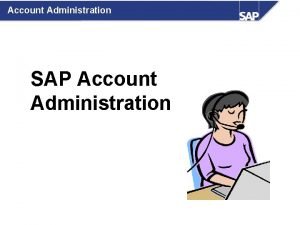Methods of Administration MOA Element 8 Complaint Processing























































- Slides: 55

Methods of Administration MOA Element 8 Complaint Processing Procedures

Agenda • Presentation: Presentation Learning Objectives • Presentation: General Requirements • Presentation: Recipient Processing Procedures • Activity: Distinguishing Complaints of Discrimination vs Program Complaints 8 -1

Agenda • Presentation: • Activity: • Presentation: Handling Complaints Filed Against Another Federal Agency Required Record Keeping Complaints Against Non-DOL Funded Partners Supporting Documentation State’s Implementation of Complaint Process Procedures 8 -2

Learning Objectives • Explain the general requirements for complaint processing procedures. • Convey the required recipient complaint processing procedures. • Distinguish between discrimination complaints and program complaints. 8 -3

Learning Objectives • Inform complainants of their rights and the appropriate process in filing complaints. • Define how the state guarantees compliance with Complaint Processing Procedures 8 -4

General Requirements • Each state must adopt and publish procedures for processing complaints alleging discrimination against any WIOA recipient (29 CFR 38. 77) • The Governor, LWSA, and the EO Officers are responsible for developing and publishing complaint procedures (29 CFR 38. 77) • The EO Officer is responsible for ensuring that recipients follow procedures for processing discrimination complaints under 29 CFR 38. 76 – 38. 79. (29 CFR 38. 25 [d]) • The procedures must provide the complainant with the option to file with the recipient or directly with CRC. (29 CFR 38. 71 and 38. 76) • All recipients must comply with the complaint procedures. (29 CFR 38. 77) 8 -5

Term to Know - Recipient Any entity to which financial assistance under WIOA Title I is extended, either directly from the USDOL or through the Governor or another recipient; excluding the ultimate beneficiaries of the WIOA Title I funded programs or activities. 8 -6

General Requirements • Recipients That Must Comply With Complaint Procedures § State-level agencies that administer WIOA funds § State Employment Security Agencies (UI) § State and Local Workforce Development Boards § LWSA Grant recipients § One-Stop Operators 8 -7 § Providers of services, and benefits

General Requirements • Recipients That Must Comply With Complaint Procedures § On-the-job (OJT) employers § Job Corps contractors and center operators (excluding federally operated centers) § Placement agencies, including Job Corps contractors that perform these functions § One-Stop partners 8 -8

Recipient Complaint Processing Procedures • Jurisdiction • Methods of Resolution/Disposition • Notice of Final Disposition Processing • Processing Time Frames • Recording Keeping 8 -9

Recipient’s Complaint Processing Procedures • Jurisdiction § Types of Complaints § Who May File a Complaint § Information Required for Complaint § Complaint Form to be Used § Time Frames for Filing 8 -10

Types of Complaints • Individual • Class Action Complaint • Third Party Complaint 8 -11

Who May File A Complaint? • Who May File a Complaint? § Any person, or any specific class of individuals, who believes that they have been or are being subjected to discrimination prohibited under WIOA. 8 -12

Who May File A Complaint? • Examples of who may file: § Applicant/registrant for aid, benefits, services, or training § Eligible applicants/registrants § Participants § Employees § Applicants for employment § Service providers who may be attributed a racial, national origin or other characteristic entitled to protection under WIOA § Eligible service providers 8 -13

Information Required for a Complaint • Complainant’s name/address or another means of contracting the complainant • Identity of the respondent (individual or entity alleged to have discriminated) • Allegations described in sufficient detail to determine whether: § Complaint is covered as applicable under CRC’s or the Recipient’s jurisdiction § Complaint was filed within specified time § Complaint has apparent merit • A signature from the complainant or their authorized representative 8 -14

Term to Know - Apparent Merit Apparent merit means that the allegation of discrimination, or complaint, if proven to be true, would violate WIOA regulations. There is no apparent merit if the allegation of discrimination does not reference a basis prohibited under Section 188 of WIOA. 8 -15

Form To Be Used in Filing a Complaint • Complaint form developed by the state • Complaint Information Form (CIF) developed by the CRC • Any other document that includes the required information 8 -16

Time Frame for Filing a Complaint • A complaint must be filed: § Within 180 days of the alleged discrimination üAn extension of the 180 -day filing period may be granted for good cause shown by the complainant – Only the Director of CRC can grant this extension 8 -17

Due Process Guarantees • Agencies receiving and processing complaints are required to provide notice to all parties who have a legitimate interest in the complaint. • Regulations require that an “impartial” decision-maker investigate and process complaints. 8 -18

Due Process Guarantees • Agencies are required to notify complainants of their rights to: Representation § Present evidence § Question others who present evidence § File with CRC when they are not satisfied with an agency’s decision • Decisions should be made strictly on the basis of evidence gathered. 8 -19

Specific Required Elements 1. Initial written notice 2. Written statement of issues 3. Process for fact-finding 4. Alternative Dispute Resolution process 5. Written Notice of Final Action 8 -20

Specific Required Elements 1. Initial written notice including: § § Acknowledgment of the written complaint Notice to the complainant of his or her right to be represented in the complaint process 2. Written statement of issues including: § § List of the issues raised in the complaint Statement whether the recipient accepts the issue for investigation or rejects the issue and the reasons for each rejection 8 -21

Specific Required Elements 3. Process for investigation or fact-finding § The choice to use customary process rests with the complainant 4. Alternative Dispute Resolution Process § § Choice for the complainant to use ADR or the customary process Provision for any party to file a complaint with the CRC Director if ADR agreement is breached 8 -22

Specific Required Elements 5. Written Notice of Final Action including: § The recipient’s decision and explanation (investigation or fact-finding) or a description of the resolution (ADR). § A notice stating that if the complainant is dissatisfied with the recipient’s resolution of the complaint, he or she has the right to file a complaint with CRC within 30 days 8 -23

Acceptance for Investigation or Rejection by the Recipient • Determining Jurisdiction § Respondent is a WIOA Recipient § Complaint has been filed within the 180 -day time period, or the Director of CRC has granted an extension waiver § The complaint issue is covered under Section 188 of WIOA 8 -24

Acceptance for Investigation or Rejection by the Recipient • Discrimination Complaints vs. Program Complaints § WIOA complaints can be divided into 2 categories: ü Discrimination complaints, processed according to ETA regulations ü Program complaints, processed according to ETA regulations 8 -25

Acceptance for Investigation or Rejection by the Recipient • Discrimination vs. Program Complaints (cont. ) Elements included Discrimination Complaint An issue A prohibited basis Program Complaint An Issue A non-prohibited basis Procedures to CRC regulations at ETA regulations follow 29 CFR 38 at 20 CFR Subpart F, Sec. 667. 600 [a][b] 1 -26

Acceptance for Investigation or Rejection by the Recipient Example 1: • A WIOA participant in an On-the-Job Training (OJT) Program believes that he is being treated unfairly and wants to file a complaint. He says his employer has refused to supply him with work uniforms and safety shoes that are provided, free of change, to other employees doing similar work. He further states that two of the other employees who have received free uniforms and shoes are also WIOA OJT participants. 8 -27

Acceptance for Investigation or Rejection by the Recipient Example 2: • A WIOA participant in an OJT training program believes that he is being treated unfairly and wants to file a complaint. He says his employer has refused to supply him with work uniforms and safety shoes that are provided, free of charge, to white employees doing similar work. He further states that he knows of two other employees who have received free uniforms and shoes who are white and who are also WIOA OJT participants. He believes he is being treated unfairly because he is Hispanic. 8 -28

Acceptance for Investigation or Rejection by the Recipient • No Jurisdiction § Recipient must send the complainant a Written Notice of Lack of Jurisdiction including: ü The reason(s) for the determination ü Notice that the complainant has a right to file a complaint with CRC within 30 days of receiving the Written Notice of Lack of Jurisdiction 8 -29

Processing Timeframe Requirements 1. Recipient’s 90 -Day Processing Timeframe 2. Complainant’s 30 -day Timeframe for Appeals 3. Extension of Complainant’s 3 -Day Timeframe to Appeal 8 -30

Processing Timeframe Requirements 1. Recipient’s 90 -day Processing Timeframe § Issue a Written Notice of Lack of Jurisdiction § Refer the complainant to another federal grant-making agency for investigation where there is dual jurisdiction § Issue a Written Notice of Final Action 8 -31

Processing Timeframe Requirements 2. Complainant’s 30 -Day Timeframe for Appeals § § Recipient issues a Written Notice of Lack of Jurisdiction Recipient fails to issue either a Written Notice of Lack of Jurisdiction, a Written Notice of Final Action, or a referral to another federal grantmaking agency within the 90 -day timeframe A party to an agreement breaches the agreement An ADR process fails to produce an agreement 8 -32

Processing Timeframe Requirements 3. Extension of Complainant’s 30 -Day Timeframe Appeal § CRC Director may extend the complainant’s 30 -day timeframe if the complainant can show good cause. 8 -33

Activity: Distinguishing Complaints of Discrimination vs. Program Complaints Purpose: B To identify acceptable discrimination complaints Task: • You are a member of the CRC review team. You have been asked to review letters of compliant to determine whether an EO Officer has jurisdiction under Section 188 of WIOA. § Take 5 minutes to review the prohibited bases for discrimination. § Decide whether the complaint is covered under Section 188 of WIOA and why. § Share your findings with the class. Time: @ 20 minutes 8 -34

Handling Complaints Against One-Stop Partners Financially Assisted by Agencies Other than DOL 1. Dual Jurisdiction 2. Sole Jurisdiction 8 -35

Handling Complaints Against One-Stop Partners Financially Assisted by Agencies Other than DOL 1. Dual Jurisdiction § The CRC Director or recipient refers the complaint to the grant-making agency for processing following that agency’s regulations. 2. Sole Jurisdiction § The CRC or recipient retains the complaint and processes it following Section 188 of WIOA, 29 CFR 38 8 -36

Handling Complaints Against One-Stop Partners Financially Assisted by Agencies Other than DOL • Examples of federal grant-making agencies that participate as a partner in a One-Stop delivery system § Dual Jurisdiction § Department of Education (DOE) § Department of Health and Human Services (HHS) 8 -37

Handling Complaints Against One-Stop Partners Financially Assisted by Agencies Other than DOL (cont. ) § Department of Housing and Urban Development (HUD) § Department of Agriculture (USDA) § Department of Transportation (DOT) 8 -38

Steps in Determining Type of Jurisdiction • Step 1: Identify the alleged discriminatory decision/action § Example: denied training • Step 2: Identify the entity (program or activity operated as part of a One-Stop) in which the alleged discriminatory decision/action occurred. § Example: TANF 8 -39

Steps in Determining Type of Jurisdiction (cont. ) • Step 3: Identify the primary source of federal financial assistance of the entity against which the complaint is filed. § Example: DOL 8 -40

Steps in Determining Type of Jurisdiction (cont. ) • Step 4: Determine whether the basis for the alleged discrimination involves one or more of the following bases: § § § § Race Sex National origin Color Disability § Age § Religion § Political affiliation or belief § Citizenship (beneficiaries only) § Participation in WIOA Title I program or activity (beneficiaries only) 8 -41

Steps in Determining Type of Jurisdiction (cont. ) • Step 5: Determine whether the allegations, if true, would violate Section 188 of WIOA or any of the following: Title VI, Title IX, Section 504, Title II of ADA, or the Age Discrimination Act. 8 -42

Dual Jurisdiction Exists When: • Primary source of federal financial assistance of the entity against which the allegations are filed is a federal grant-making agency other than DOL § Basis for the allegation involves one or more of the following: üRace üSex üNational origin üColor üDisability üAge 8 -43

Dual Jurisdiction • Allegation, if determined to be true, would violate one or more of the following: § § § Title VI Title IX Section 504 Title II of ADA Age Discrimination Act Section 188 of WIOA 8 -44

Dual Jurisdiction • When Dual Jurisdiction exists, the agency receiving the compliant must: § Refer the complaint to the federal grantmaking agency’s Office of Civil Rights, National Office in DC to be processed in accordance with the agency’s complaint investigation procedures. § Sample letter of referral is in your appendix § Notify the complainant and the respondent of the referral. 8 -45 üSample notification letter in your appendix

Sole Jurisdiction Exists When: • The primary source of federal financial assistance of the entity against which the allegations are filed is a federal grant-making agency other than DOL. • The allegation(s), if true, would violate Section 188 of WIOA. • The allegation is not based on a civil rights law enforced by the other grant-making agency. 8 -46

Memorandums of Understanding (MOU) Agreements Between USDOL CRC and Other Grant-Making Agencies The only MOU agreement that has been executed that sets out the procedures for processing complaints filed with another federal grant-making agency is between DOL CRC and DOE OCR. §A copy is in your appendix 8 -47

Memorandums of Understanding (MOU) • CRC will continue to work with federal grant-making agencies to finalize MOUs. In the interim, procedures in the MOU agreement with DOE OCR are to serve as the guideline. • Questions regarding referral of complaints to another federal grantmaking agency should be directed to the CRC Director. 8 -48

Activity: Procedures For Handling Complaints Against One-Stop Partners Funded By An Agency Other Than DOL Purpose: B To determine if a complaint is Sole Jurisdiction or Dual Jurisdiction Task: • You are a member of the CRC review team. You have been asked to review complaints against One. Stop partners. • Take 5 minutes to review the information on Procedures for Handling Complaints and Criteria for Determining Dual vs. Sole Jurisdiction. 8 -49

Activity: Procedures For Handling Complaints Against One-Stop Partners Funded By An Agency Other Than DOL Task: • Read the complaint scenarios. For each complaint, record the following responses: 1. Name the entity against which the complaint is filed. 2. Identify the primary source of the federal financial assistance of the entity you named 3. Describe the basis of the alleged allegation. 4. Identify the civil rights laws that are being violated if the allegations are proven to be true 5. Identify the federal Civil Rights Agency that should process the complaint and explain your rationale. 6. Explain whether the compliant constitutes dual jurisdiction or sole jurisdiction under WIA 29 CFR 38 and why. 7. Describe the action you would take to complete processing 8 -50 of this compliant

Record-Keeping Requirements • • • Name and address of the complainant Basis of the compliant Description of the complaint Date when the compliant was filed Disposition of the complaint and the date the disposition was issued • Other pertinent information 8 -51

Supporting Documentation to Accompany the MOA • A copy of the state’s discrimination complaint procedures developed pursuant to the regulatory requirements of the regulations • A copy of directives, memoranda, or any other instruments used to inform recipients of the compliant procedures • A copy of the ADR procedures, if not included with the complaint processing 8 -52

The State’s Procedures for Complaint Processing • Your state’s MOA describes: § How the state will communicate policies, procedures and systems to all recipients § How the recipients have made, and will continue making, efforts to ensure proper complaint processing § How the state will support and evaluate the success of its recipients’ complaint processing efforts 8 -53

Methods of Administration MOA Element 8 Complaint Processing Procedures
 Wax pattern in dentistry
Wax pattern in dentistry Finite element method
Finite element method Finite element methods
Finite element methods Difference between signal element and data element
Difference between signal element and data element Signal element vs data element
Signal element vs data element Polymer processing methods
Polymer processing methods Market form of fresh meat
Market form of fresh meat Methods of instrument processing
Methods of instrument processing What effortful processing methods aid in forming memories?
What effortful processing methods aid in forming memories? Bottom up and top down processing
Bottom up and top down processing Bottom up processing vs top down processing
Bottom up processing vs top down processing Bottom up processing example
Bottom up processing example High boost filtering matlab
High boost filtering matlab Secondary processing of food
Secondary processing of food Fractal image
Fractal image Histogram processing in digital image processing
Histogram processing in digital image processing Parallel processing vs concurrent processing
Parallel processing vs concurrent processing Neighborhood processing in digital image processing
Neighborhood processing in digital image processing What is point processing in digital image processing
What is point processing in digital image processing Thinning and thickening in image processing example
Thinning and thickening in image processing example Top bottom processing
Top bottom processing What is interactive processing
What is interactive processing Pqrstu mnemonic
Pqrstu mnemonic Hogo 123
Hogo 123 Complaint tone
Complaint tone Cc hpi
Cc hpi Complaint resolution unit washington state
Complaint resolution unit washington state Dish tv complaint email id ceo
Dish tv complaint email id ceo Peter quince
Peter quince Odp of chief complaints
Odp of chief complaints Sample complaint form
Sample complaint form Sample complaint form
Sample complaint form Chief complaint of hemorrhoids
Chief complaint of hemorrhoids Diarrhea chief complaint
Diarrhea chief complaint Chief complaint of malnutrition
Chief complaint of malnutrition Handling complaint ppt
Handling complaint ppt Customer complaint student response worksheet
Customer complaint student response worksheet Complaint handling definition
Complaint handling definition Chief complaint of colostomy
Chief complaint of colostomy Doriflex
Doriflex History taking format
History taking format Complaint dialogue 3 person
Complaint dialogue 3 person Omma employment verification
Omma employment verification Complaint against depository participant
Complaint against depository participant Epso results
Epso results Chief complaint template
Chief complaint template Presenting complaints of hypertension
Presenting complaints of hypertension General banking guidelines of bangladesh bank
General banking guidelines of bangladesh bank Presenting complaint
Presenting complaint Complaint letter parts
Complaint letter parts Resolve hrs
Resolve hrs 21cfr820.198
21cfr820.198 Presenting complaint
Presenting complaint Irda complaint
Irda complaint Nadra database management system
Nadra database management system Carbonic anhydrase inhibitor moa
Carbonic anhydrase inhibitor moa

